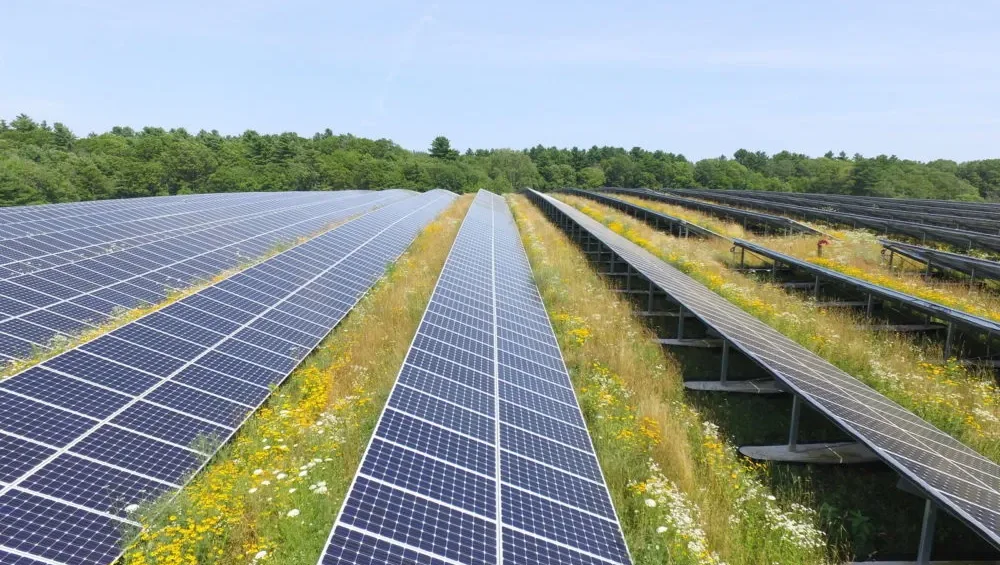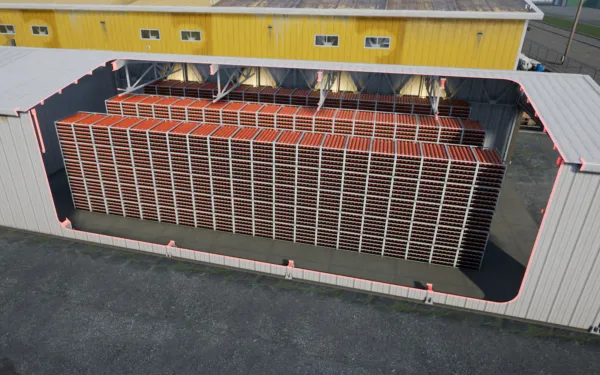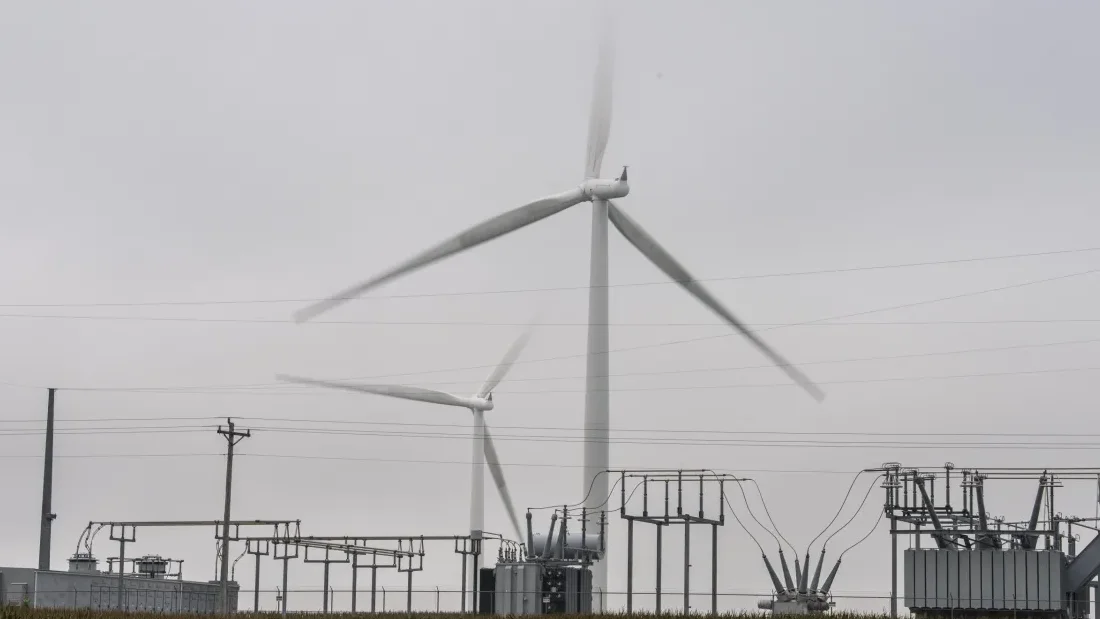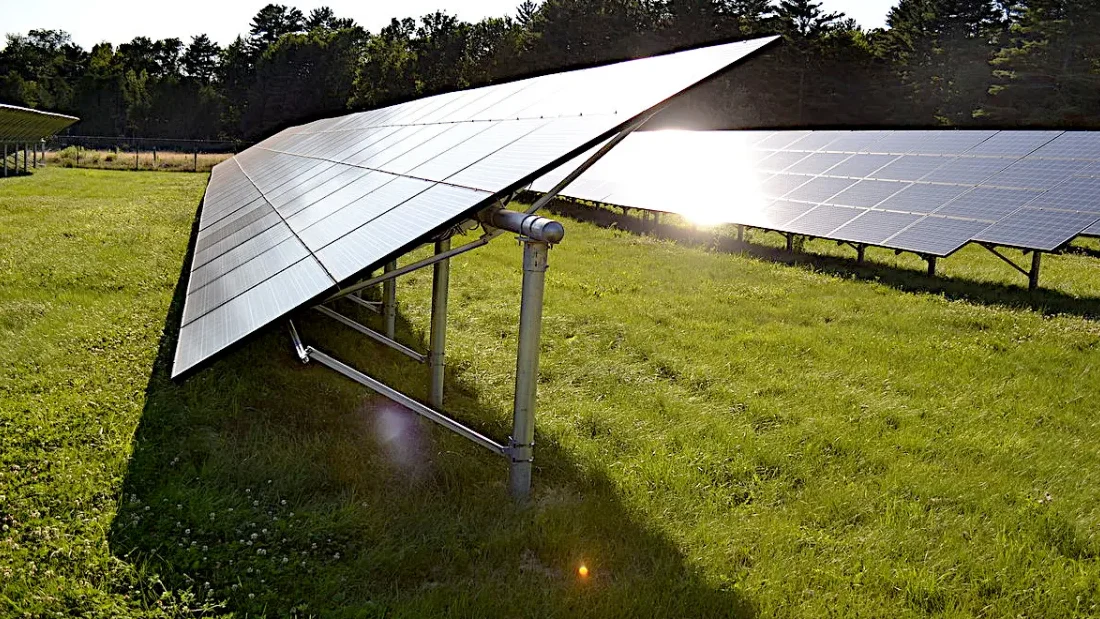
CLEAN ENERGY: The U.S. Interior Department finalizes a rule that will cut fees as much as 80% for solar and wind projects on federal land as it celebrates a milestone of permitting more than 25 GW of renewable projects under President Biden. (The Hill, Reuters)
ALSO: An Indigenous researcher says tribes need application support, better access to information, and resources to build better infrastructure, to in addition to funding to adopt clean energy. (Grist)
CLIMATE: While the world’s biggest companies are making stronger climate commitments, an analysis finds they’re still insufficient to meet Paris Agreement goals. (Grist)
GRID: About 2.6 TW of power projects — 95% of them solar, battery and wind developments — were waiting to connect to the U.S. grid at the end of last year, up 27% from the year before. (Utility Dive)
SOLAR:
HYDROGEN: Xcel Energy says plans for an Upper Midwest hydrogen hub are jeopardized by proposed federal tax credit rules that would bar utilities from diverting existing clean energy generation to power hydrogen facilities. (Star Tribune)
OIL & GAS: Oil companies challenge a federal regulation requiring former owners to clean up abandoned offshore oil and gas infrastructure along California’s coast, potentially leaving taxpayers to pick up the multimillion-dollar bill. (E&E News)
COAL:
EMISSIONS:
EFFICIENCY: Advocates push the U.S. Energy Department to speed up its updating of appliance efficiency standards. (Utility Dive)
ELECTRIC VEHICLES: Michigan is offering millions of dollars in funding to bolster research on recycling materials from electric vehicle batteries. (IPR)
UTILITIES: Questions still abound about the Tennessee Valley Authority CEO’s decision to replace a Tennessee coal plant with a gas plant and pipeline without public approval by the TVA board, and despite warnings from the U.S. EPA that the environmental review underlying the project was inadequate. (WPLN)
COMMENTARY: Utilities are overstating the urgency of their need for new power to meet increasing demand, and should pause to consider alternatives to gas, two clean electricity advocates write. (Utility Dive)

CLEAN ENERGY: The U.S. Interior Department finalizes a rule that will cut fees as much as 80% for solar and wind projects on federal land as it celebrates a milestone of permitting more than 25 GW of renewable projects under President Biden. (The Hill, Reuters)
ALSO: An Indigenous researcher says tribes need application support, better access to information, and resources to build better infrastructure, to in addition to funding to adopt clean energy. (Grist)
CLIMATE: While the world’s biggest companies are making stronger climate commitments, an analysis finds they’re still insufficient to meet Paris Agreement goals. (Grist)
GRID: About 2.6 TW of power projects — 95% of them solar, battery and wind developments — were waiting to connect to the U.S. grid at the end of last year, up 27% from the year before. (Utility Dive)
SOLAR:
HYDROGEN: Xcel Energy says plans for an Upper Midwest hydrogen hub are jeopardized by proposed federal tax credit rules that would bar utilities from diverting existing clean energy generation to power hydrogen facilities. (Star Tribune)
OIL & GAS: Oil companies challenge a federal regulation requiring former owners to clean up abandoned offshore oil and gas infrastructure along California’s coast, potentially leaving taxpayers to pick up the multimillion-dollar bill. (E&E News)
COAL:
EMISSIONS:
EFFICIENCY: Advocates push the U.S. Energy Department to speed up its updating of appliance efficiency standards. (Utility Dive)
ELECTRIC VEHICLES: Michigan is offering millions of dollars in funding to bolster research on recycling materials from electric vehicle batteries. (IPR)
UTILITIES: Questions still abound about the Tennessee Valley Authority CEO’s decision to replace a Tennessee coal plant with a gas plant and pipeline without public approval by the TVA board, and despite warnings from the U.S. EPA that the environmental review underlying the project was inadequate. (WPLN)
COMMENTARY: Utilities are overstating the urgency of their need for new power to meet increasing demand, and should pause to consider alternatives to gas, two clean electricity advocates write. (Utility Dive)

At 1.5 megawatts, the battery destined for a college campus near Petersburg, Virginia, might not be the mightiest in Dominion Energy’s growing storage fleet.
But don’t underestimate its power and reach.
In addition to providing backup power for Virginia State University’s main sports and entertainment venue, it will serve as a hands-on laboratory and research project for engineering students and faculty at the historically Black university.
“This is so exciting,” said Dawit Haile, dean of VSU’s College of Engineering and Technology. “Our students don’t know the challenges we are having to save energy when you need it later. Storage is the missing piece.”
It isn’t the first time the 4,000-student university has collaborated with the state’s biggest utility. For several years, Dominion has lined up professionals to teach students enrolled in a specialized power and energy curriculum.
That relationship prompted Haile to nudge Dominion when he found out the utility was seeking sites to test metal-hydrogen battery technology instead of a more commonplace lithium-ion model. The appeal of metal-hydrogen, a standard in the aerospace industry, is that the materials are longer-lasting and much slower to discharge.
“We were actually looking for a university so we could pull in the learning aspect,” said Dominion’s Ellen Jackson, program manager for the pilot project. “VSU really wants this to be a visible part of their campus.”
Utility regulators are now reviewing the proposal, which a hearing examiner with the State Corporation Commission has already recommended for approval. If greenlighted, it is expected to be operational by the end of 2027.
“Cost for the whole kit and caboodle is $14.4 million,” Jackson said, referencing the architectural design, construction and installation of a final product with a footprint that will likely include more than two dozen containers measuring 11 feet by 9 feet.
Haile, who has taught at VSU for 27 years, is eager for students to dive into lessons about battery configuration, building and maintenance. Collected data will help them assess efficiency, longevity and operational costs.
“So many of us take it for granted that energy powering our homes will be there, and we don’t think about the source,” he said. “Any opportunity we get to help students learn more about this profession, it’s a plus.”

The VSU pilot project is a small slice of the volume of battery storage the General Assembly expects Dominion to meet to comply with the Virginia Clean Economy Act.
By next year, that number needs to reach 250 MW. Targets are slated to rise to 1,200 MW by 2030 and then more than double to 2,700 MW by 2035. Dominion is aiming for 65% of the battery projects to be company-owned and the remainder to be power purchase agreements with third-party owners.
“We’re well on our way to meeting that first target,” said Brandon Martin, who manages a business development team that oversees Dominion’s battery projects. “We’ve seen a lot of pricing volatility, but some of that will start to work its way out.”
Thus far, Dominion has petitioned the State Corporation Commission for a total of 180 MW of battery storage projects. Of those, 98 MW are company-owned and the remaining 82 MW have third-party owners with power purchase agreements.
The largest one that regulators have approved is at Dulles International Airport in Northern Virginia’s Loudoun County.
Once completed in late 2026, it will generate up to 100 MW of solar energy and store up to 50 MW of power, enough clean energy to electrify more than 37,000 Virginia homes at peak output. Dominion broke ground on that project last August.
“In the big picture, battery storage might be in its infancy, but it’s the unsung hero of the renewable energy profile,” Martin said. “It’s critical to be able to store and discharge when the sun isn’t shining and the wind isn’t blowing.”
Meanwhile, the 1.5 MW initiative for VSU is one of three non-lithium-ion battery projects — totaling about 10.5 MW — under review by regulators. Other pioneering projects in the mix are a 5 MW iron-air battery and a 4 MW zinc-hybrid battery that Dominion plans to install at the gas-fired Darbytown Power Station in Henrico County, near Richmond.
If approved, construction on the pair of Darbytown pilots would be operational by late 2026.
Batteries aren’t a one-size-fits-all technology, said Martin, adding that smaller projects are geared for the distribution side of electron delivery.
“Trying out nascent technologies is going to be critical for future deployment,” he said. “Utilities need to know if they’ll perform as anticipated.”
Interim energy storage targets spelled out in the Clean Economy Act allow the utility to innovate with a variety of technologies before scaling up.
The advantages of experimenting with resources other than lithium is the extended discharge time, availability and durability, Martin said. For instance, an iron-air battery can discharge power for up to 100 hours. While zinc-hybrid batteries have roughly the same discharge time as a lithium-ion model, they’re manufactured with a readily accessible chemical element.
“They don’t compete with the same raw materials,” he said, referencing the high demand for lithium for electric vehicles, cell phones and other electronics. “As you’re thinking about geopolitical concerns and price volatility, these components take that out of the mix.”
Still, Martin continued, promising ideas need a path to commercialization or they will stay on a shelf gathering dust.
“It’s exciting that this space has a number of new entrants,” he said. “Other utilities will be piloting different technologies. By not all choosing the same ones, the energy community can learn what’s successful and where much quicker.
“We want to provide as many solutions as possible at the lowest cost to customers.”

The teams that both Martin and Jackson lead have spent countless hours comparing notes with utility peer groups, technology vendors and experts at the nonprofit Electric Power Research Institute (EPRI) to narrow down their battery choices.
For instance, Dominion has contracted with EnerVenue, a California company, to build the metal-hydrogen battery for the VSU campus.
The company, founded in 2020 by a Stanford University materials science researcher, is borrowing the same technology that the National Aeronautics and Space Administration deployed to power signature — and distant — enterprises such as the Hubble Space Telescope, the Mars Exploration Rovers and the International Space Station.
“This is a proven chemistry that we are commercializing for the grid,” said Brad Dore, EnerVenue’s vice president of global marketing. “The difference is that NASA didn’t have to care about the cost — and we do.”
In a nutshell, here’s how it works. During the energy charging process, the water inside the vessel is split, creating hydrogen gas. At discharge, that gas recombines into water.
Such batteries can discharge for up to 12 hours, said Dore, more than double the capability of a typical lithium-ion battery.
He emphasized that the charging process is stable, repeatable and doesn’t cause the degradation common with battery chemistries such as lithium-ion. The other plus, he added, is that the metal, which is 99% nickel, means most of the battery is recyclable when it does finally wear out.
Once Dominion partnered with VSU, the utility collaborated with EPRI researchers to sort through technologies and manufacturers, as well as basics such as cost and land footprint.
“They did a lot of the legwork for us,” Jackson said about matching a battery with the 6,000-seat Multi-Purpose Center, which attracts audiences from the university and the community.
Fortunately, the battery won’t have to be shipped from California because EnerVenue announced a year ago that it is constructing an energy storage factory in Shelby County, in north central Kentucky. That will translate to a much shorter trip to the Petersburg campus three years from now.
In the meantime, Haile and fellow faculty members are creating a power storage curriculum.
The professor is already anticipating the new battery could be a springboard to attract more on-campus energy storage projects as the technology evolves.
“The potential is huge,” he said. “Our mission here is access and opportunity, so to be able to show our students what the future is, that’s a big deal.”

WIND: After “inflammatory rhetoric” about renewables discouraged bids in last year’s auction of offshore wind leases near Texas, federal officials are shifting their attention to areas off Louisiana instead. (Louisiana Illuminator)
ALSO:
CLEAN ENERGY:
OIL & GAS:
ELECTRIC VEHICLES:
HYDROGEN: Environmental advocates and residents who live near a proposed Appalachian hydrogen hub express concerns about the project’s potential to disrupt their lives and prolong the region’s dependence on fossil fuels. (WV Metro News)
CARBON CAPTURE: A Virginia company claims it successfully used carbon capture technology to grow lettuce at an indoor farm. (Roanoke Times)
CLIMATE:
GRID: Oklahoma lawmakers consider legislation to give utilities more of a stake in building electric transmission lines while moving oversight of bidding, construction and operations from federal to state officials. (NonDoc)
COMMENTARY: Federal money intended to fight climate change in Louisiana is set to pay for carbon capture projects that will perpetuate the oil and gas industry, writes a professor. (The Conversation)
.webp)
COAL: North Dakota officials prepare to launch a court challenge against a forthcoming final federal rule that aims to cut mercury emissions from lignite coal-burning power plants. (North Dakota Monitor)
GRID:
UTILITIES:
SOLAR:
PIPELINES: In an unusual move, Iowa House Democrats provided no comments before unanimously approving a carbon pipeline siting bill, allowing Republican backers to champion the legislation as a win for property rights. (Bleeding Heartland)
CLEAN ENERGY:
ELECTRIC VEHICLES:

OFFSHORE WIND: The Biden administration gives the greenlight to two New England offshore wind farms — the Park City and Commonwealth wind projects — bringing the country one-third of the way to the president’s offshore wind goal. (E&E News, Bloomberg)
ALSO: Rhode Island officials unveil a new tool to help them avoid locating projects — like offshore wind and aquaculture facilities — where recreational fishers enjoy going. (ecoRI)
MINING: A Maine legislative committee advances new environmental regulations that companies would have to fulfill before getting mineral extraction exemptions to the state’s open pit mining ban, ahead of allowing testing in Newry’s lithium-rich mineral deposit. (Portland Press Herald)
HYDROPOWER: A Vermont utility wants to give its unprofitable but popular Green River Reservoir dam to the state to spare ratepayers the cost of operating it, and a study is underway now to see how much it would cost the state to take over. (VT Digger, WCAX)
CLEAN ENERGY:
GRID: In Maryland, top environmentalists and lawmakers hash out a compromise to lower environmental processes for data centers in exchange for earmarked tax revenue for clean energy and climate program funding. (Maryland Matters)
FOSSIL FUELS:
TIDAL: A developer files a preliminary permit application with federal energy regulators to resurrect a tidal power project on northeastern Maine’s Pennamaquan River, but the adjacent town says such development would harm native fish. (Bangor Daily News)
ELECTRIC VEHICLES: At a press conference on delivery workers, New York City’s mayor declines to answer questions about required e-bike registration and creating a battery swap program codified into law last fall. (Streetsblog)
CLIMATE: Maine’s working waterfronts are heavily exposed to symptoms of the climate crisis, including rising sea levels and extreme storms, but aren’t uniformly prepared to mitigate their circumstances. (Bangor Daily News)
SOLAR: A developer schedules a public open house so northern New York community members living near their proposed 200 MW solar farm can learn more and ask questions. (NNY360)

SOLAR: Virginia regulators approve a total of 764 MW in new solar power for Dominion Power, including four new solar farms totaling 329 MW plus 13 power purchase agreements with independent projects. (Richmond Times-Dispatch, Power Engineering)
ALSO:
OVERSIGHT:
CARBON CAPTURE:
COAL:
ELECTRIC VEHICLES:
WIND: Dominion Energy agrees to pay $290,000 to a Virginia city and $650,000 to a historic lighthouse to compensate for the visual impacts of its planned offshore wind farm. (WTKR)
OIL & GAS:
GRID:

COAL: Rocky Mountain Power cancels plans to close two Utah coal plants by 2032 and replace them with nuclear reactors after a court blocks a federal ozone-pollution rule in the state. (Salt Lake Tribune)
ALSO: Federal regulators block a Montana law that would have allowed coal mines to violate water quality standards for a limited time after finding it didn’t meet minimum requirements. (Daily Montanan)
OIL & GAS: Advocates say a California city’s primary news source refuses to report on a Chevron petroleum refinery’s pollution and accidents because the oil company owns the outlet. (Floodlight)
SOLAR:
WIND: Oregon’s commercial fishing industry calls on Gov. Tina Kotek to urge the Biden administration to postpone a planned offshore wind lease auction until the state finalizes its roadmap for the development. (Oregonian)
EFFICIENCY: The U.S. Energy Department awards a Colorado company $22 million to implement an aluminum milling process that requires less heating and cooling. (Colorado Sun)
TRANSPORTATION: New Mexico seeks $577 million in federal grants to help establish hydrogen fueling and electric vehicle charging centers for long-haul freight trucks along Interstate 40, and to fund a clean truck incentive program. (news release)
ELECTRIC VEHICLES: A court rejects Tesla’s bid to dismiss a federal lawsuit accusing the company of widespread racism at its factory in California. (East Bay Times)
NUCLEAR: Washington state researchers work to develop new nuclear reactor cooling methods that will remain effective as the climate warms. (news release)
MINING: Southern Nevada residents and advocates push back on a proposed lithium extraction project in the Amargosa Valley, saying it could affect drinking water wells and endangered species’ habitats. (Nevada Current)
GEOTHERMAL: Colorado begins offering investment and production tax credits for researching, developing and producing geothermal energy. (news release)
GRID: Washington state researchers develop grid resilience-quantifying software aimed at determining how likely an extreme weather event is to cause a power outage. (news release)
CLIMATE: Oregon regulators begin revamping the state’s climate program that was invalidated by a federal court last year, with the goal of establishing new greenhouse gas reduction rules by the end of the year. (OPB)
COMMENTARY: A California university professor urges the Biden administration to revise its proposed Western Solar Plan to better align with conservation goals. (Bulletin of the Atomic Scientists)

TRANSITION: The Tennessee Valley Authority announces it will close a huge coal-fired power plant near Knoxville, Tennessee, that was the site of a major coal ash spill, and replace it with a 1,500 MW natural gas plant by 2027. (Knoxville News Sentinel)
ALSO: Dominion Energy’s plans to build a new natural gas-fired power plant in Virginia raises questions whether it plans to meet a state goal to entirely transition away from fossil fuels by 2045. (Virginia Business)
GRID:
ELECTRIC VEHICLES: Georgia automakers warily eye the U.S. EPA’s newly proposed rules to limit vehicle emissions as they consider adding hybrids to planned electric vehicle factories, with only financially troubled Rivian offering unequivocal support. (Atlanta Journal-Constitution)
STORAGE: A battery materials maker secures a $103 million federal tax credit for its factory in Tennessee. (Chattanooga Times Free Press, subscription)
OIL & GAS:
PIPELINES: Mountain Valley Pipeline opponents call on Virginia’s environmental agency to issue a stop-work order after it fined the pipeline $34,000 for erosion and sediment violations from last fall. (Virginia Mercury)
NUCLEAR: The second of two new reactors at Georgia Power’s nuclear Plant Vogtle reaches 100% power for the first time and is expected to enter service by June, finally signaling an end to the plant’s long-delayed, over-budget expansion. (Atlanta Journal-Constitution)
OVERSIGHT:
COMMENTARY: Virginia’s data center boom is creating an energy crisis that threatens the power grid, drinking water sources, and the state’s commitment to transition from fossil fuels, writes a columnist. (Virginia Mercury)

CLEAN ENERGY: Wind and solar are booming in Texas, with the state ranking first in the U.S. for wind energy and just behind California for solar, and renewables now accounting for a third of all power produced in the state. (Axios)
ALSO: A new report finds nine clean energy projects announced in North Carolina between 2022 and 2023 will add $10.2 billion to the state’s gross state product during construction and $593.5 million annually while they’re operating. (Raleigh News & Observer)
CLIMATE:
COAL:
SOLAR:
OIL & GAS:
GRID: A Texas appeals court allows lawsuits against transmission and distribution utilities related to the 2021 winter storm and widespread outages. (The Hill)
ELECTRIC VEHICLES: The Biden administration is largely looking to gas stations to install electric vehicle chargers, boosting companies that have long been some of the biggest sellers of fossil fuels. (E&E News)
ENVIRONMENTAL JUSTICE: Residents of a historic Black community in Alabama see an opportunity to restrict a polluting asphalt plant when its air permit comes up for renewal with state regulators. (Inside Climate News)
PIPELINES: Protesters gather outside the offices of Virginia’s environmental regulatory agency to call for greater enforcement of erosion rules against the Mountain Valley Pipeline. (WHSV)
COMMENTARY: